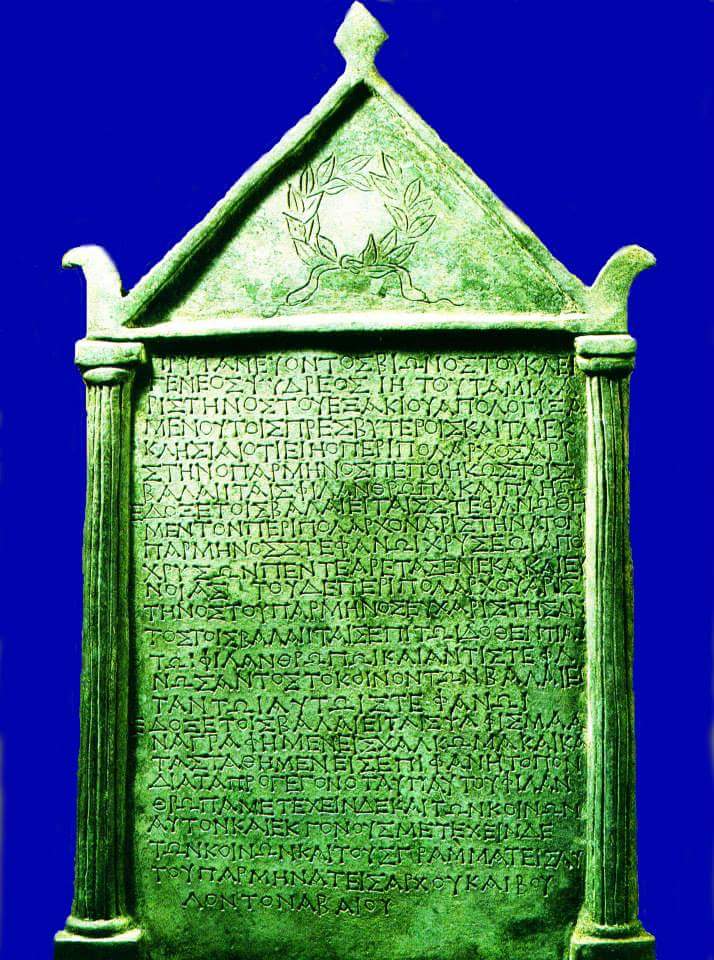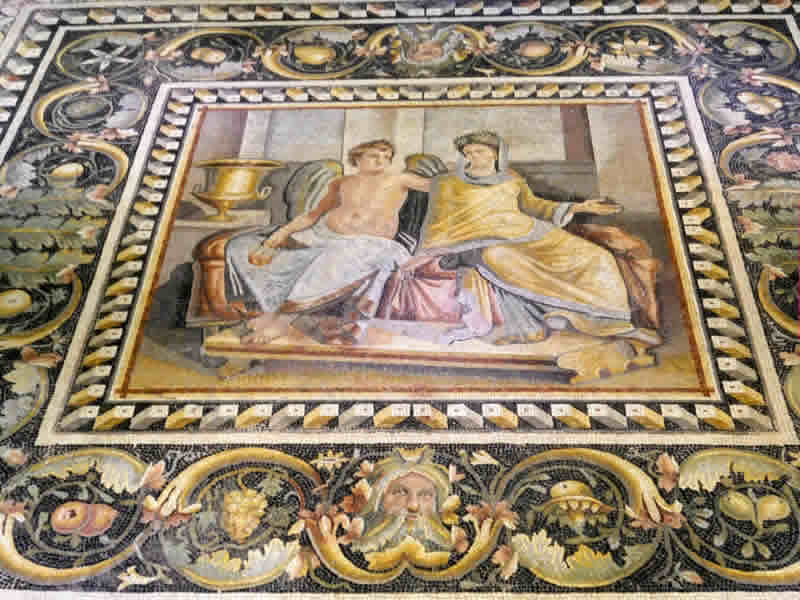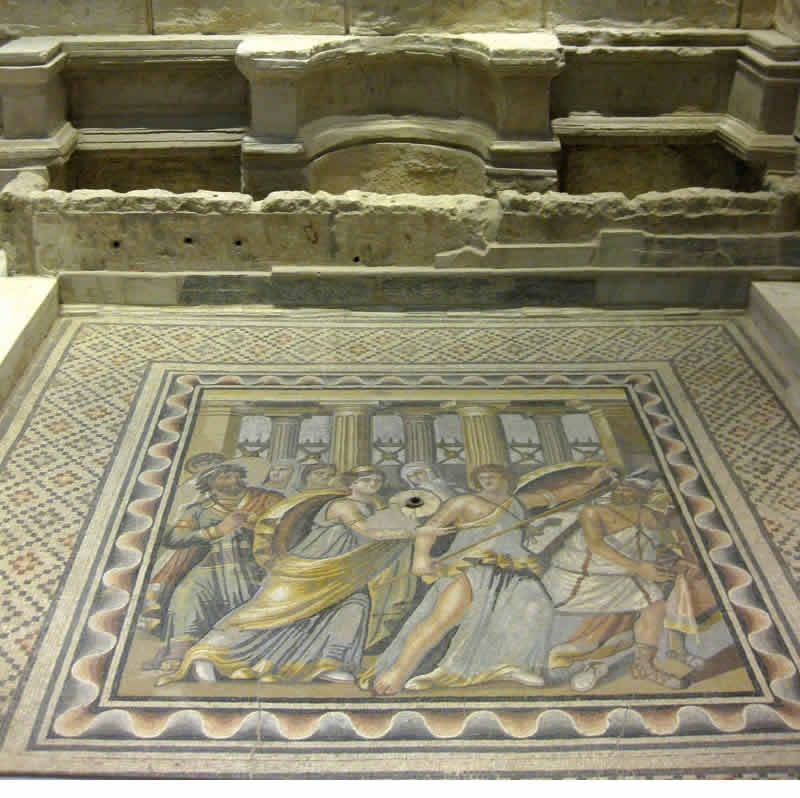|
Albania |
|
Byllis, Albania
 Illyrian Women in Albania Byllis (Ancient Greek: Βύλλις or Βουλλίς)
was an ancient city located in the region of Illyria. The remains of
Byllis are situated north-east of Vlorë, 25 kilometers from the sea in
Hekal, Fier County, Albania. Stephanus of Byzantium
mentions Byllis as a seaside city (erroneously) in Illyria and its
foundation legend, according to which the city was built by Myrmidons
under Neoptolemus, returning from the Trojan War, a tradition confirmed
by numismatics.
The Bylliones are first attested in the mid-4th century BC, in the description of the geographer Pseudo-Scylax, and also asking the oracle of Dodona to which god they should sacrifice in order to ensure the safety of their possessions. The archaeological attestation of the city is possible as far back as the second half of the 4th century BC and was later conquered by Pyrrhus. According to another view, Byllis was found by king Pyrrhus of Epirus. Byllis received sacred Greek envoys, known as theoroi during the early 2nd century BC, indicator of the city's Greek character. 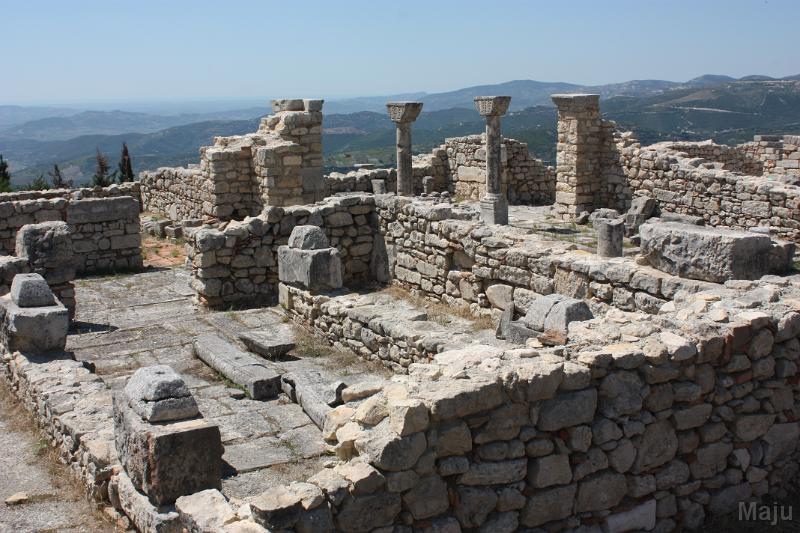 Byllis, archaeoligical site - by Maju603 Byllis, being a Greek-speaking city, on the borders of Illyria and Epirus, had its own stadium and theatre during the Hellenistic era. About its foundation it has been suggested that Byllis was founded by Greek settlers, though the fact that it had a mixed population is attested by the Illyrian names of officials. The city had its own coinage which was different from that of the tribe of the Bylliones. M. B. Hatzopoulos believes that Byllis is the northernmost non-colonian Greek city in the region. The walls of Byllis were 2,200m long, enclosing 30 hectares of a plain atop a hill 524m above sea level. There were 6 gates in the city walls. The road coming from Apollonia passed through two of them, crossing Byllis in the direction of the narrows of gorges of the Vjosa river on the way to Macedonia or those of Antigonia in the direction of Epirus. In 2011 during a road reconstruction near the archaeological park found in the site a statue of the Hellenistic era, which may depict an Illyrian soldier or a war deity, was discovered. However, there is little point in proposing an Illyrian label for city in which language, institutions, officials, onomastics, city-planning and fortifications were Greek. 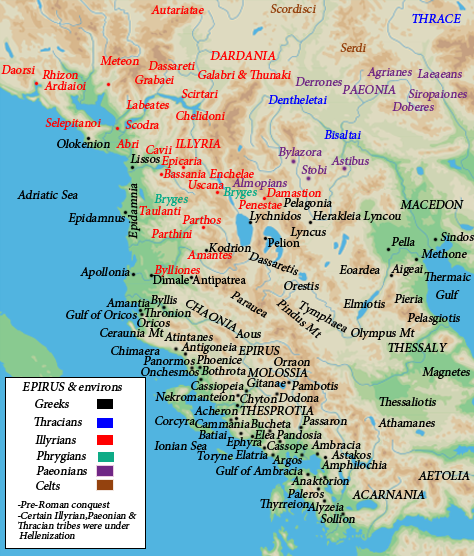 Epirus in antiquity.
League of the ByllionesThe League (Koinon) of the Illyrian tribe of the Bylliones (Ancient Greek: Κοινὸν Βυλλίων), which had been hellenized to a degree and was bilingual, was a coalition of one or two poleis, as attested after 232 BC. The league was restricted to Byllis and Nikaea, and Byllis considered Nikaia as one of its demes. Nikaia was a member of the league, as a 2nd-century BC inscription indicates. The only attestation of the city as polis is in the work of Stephanus of Byzantium in the 6th century, On the other hand the citizens of Byllis were called Byllideis (Greek: Βυλλιδεῖς). Roman and Byzantine rule Under the Roman Empire, Byllis became part of the province of Epirus Nova. The walls of Byllis carry more than four inscriptions with details regarding their construction by the engineer Victorinus, as ordered by Emperor Justinian I (483-565). 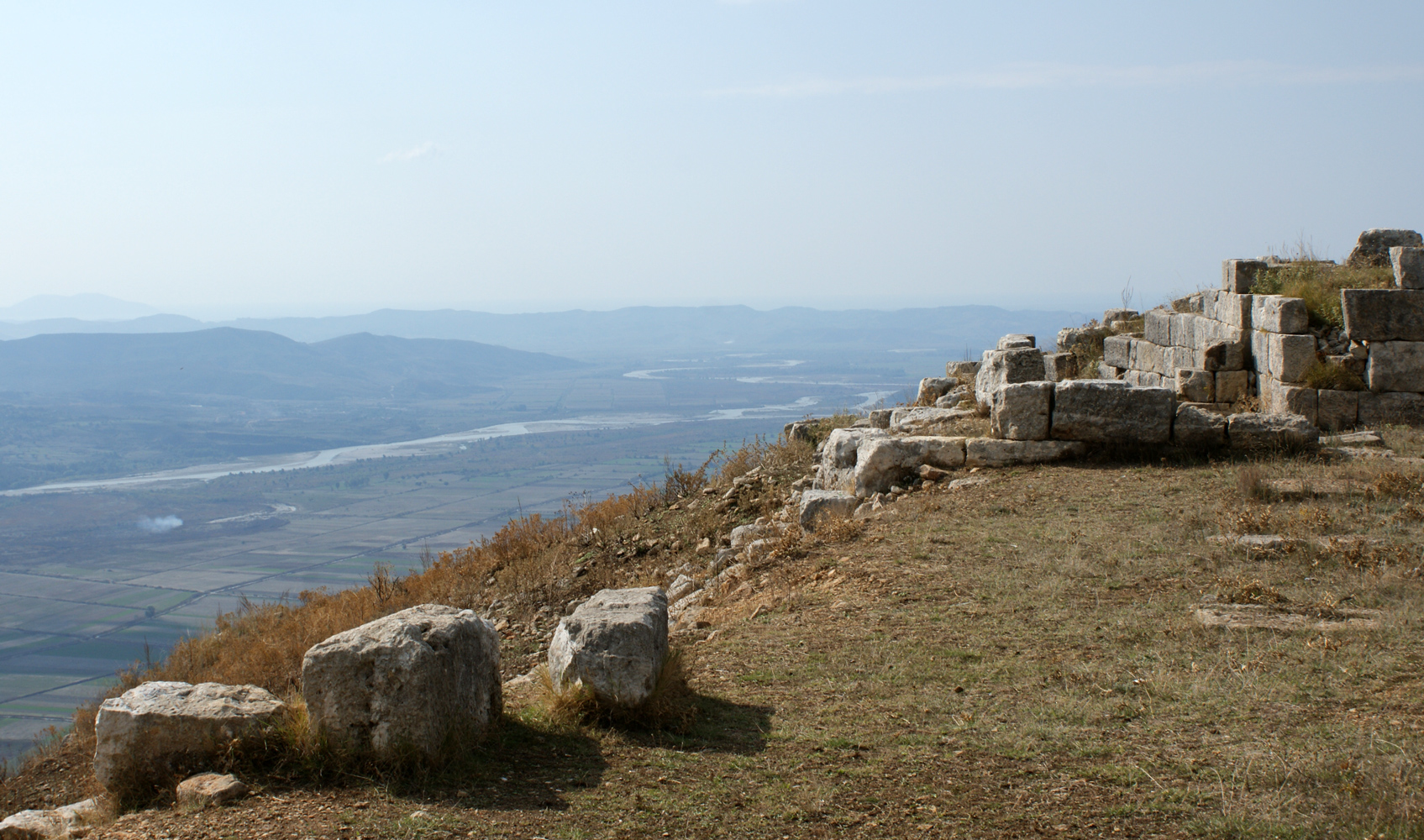 Image of the ancient site of Byllis and the river Vjosa in the distance. - by Albinfo One of the participants in the Council of Ephesus in 431 was a Felix who signed once as Bishop of Apollonia and Byllis, at another time as Bishop of Apollonia. Some assume that the two towns formed a single episcopal see, others suppose he was, strictly speaking, Bishop only of Apollonia, but was temporarily in charge also of Byllis during a vacancy of that see. At the Council of Chalcedon in 451, Eusebius subscribes simply as Bishop of Apollonia. In the letter of the bishops of Epirus Nova to the Byzantine Emperor Leo I in 458, Philocharis subscribed as Bishop of what the manuscripts call "Vallidus", and which editors think should be corrected to "Byllis". Whether Philocharis is to be considered Bishop also of Apollonia depends on the interpretation of the position of Felix in 431. The Annuario Pontificio lists Apollonia as a titular see, thus recognizing that it was once a residential diocese, a suffragan of the archbishopric of Dyrrachium. It grants no such recognition to Byllis. 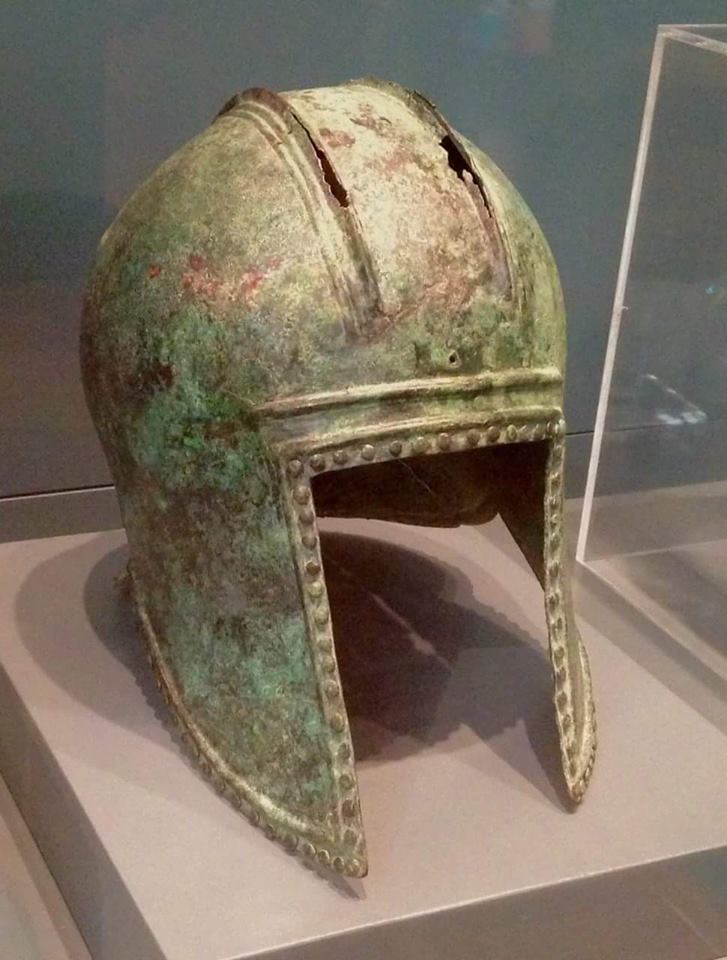 Related Links:
|
|
Zeugma, Commagene, Turkey The first
mosaic depicts the nine Muses in portraits. This mosaic was originally
in a large room of a house that archaeologists have named House of
Muses. In the center of the mosaic is Muse Calliope and she is
surrounded by her sisters. According to ancient Greek poet Isiodos,
Calliope was the greatest and finest of the nine Muses, the protector of
Epic poetry and arts. - The Greek Reporter
  The second
mosaic depicts Ocean and Tithys. What is really striking about this
mosaic is the wonderful and vivid colors used as well as the beauty of
the heroes faces. Experts say that special glass mosaic pieces have
been created for this mosaic alone. - The Greek Reporter
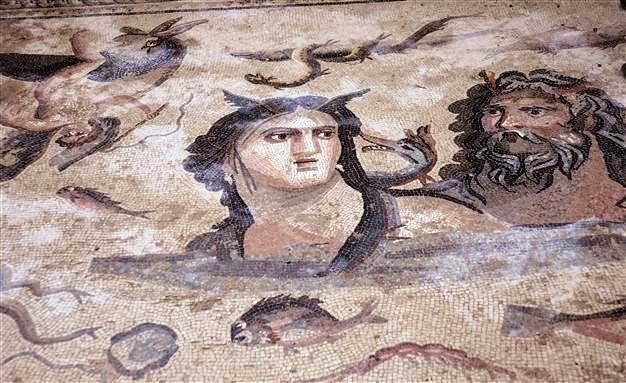 Oceanus and Tethys
which is from the Hurriyet Daily News. The photograph of Oceanus and
Tethys in the Greek Reporter is that of an earlier excavated mosaic that
is already on display at the Museum of Gaziantep - Source
Historical background Originally, the ancient city of Zeugma
was founded as a Greek settlement by Seleucus I Nicator, one of the
generals of Alexander the Great, in 300 BC. King Seleucus almost
certainly named a city Seleucia after himself; whether this city is, or
may be, the city known as Seleucia on the Euphrates or Seleucia at the
Zeugma is disputed. The population in the city at its peak was
approximately 80,000. In 64 BC the city was conquered and ruled by the Roman Empire. It is presumed that the shift of the name of the city occurred at that time. Zeugma, means "bridge-passage" or "bridge of boats". During Roman rule, the city became one of the attractions in the region, due to its commercial potential originating from its geo-strategic location because the city was on the Silk Road connecting Antioch to China with a quay or pontoon bridge across the river Euphrates, the border with the Persian Empire until the late second century. In 256, Zeugma experienced an invasion and was destroyed by the Sassanid king, Shapur I. The damage from the invasion was so drastic that Zeugma was not able to recover for a long time. To make the situation even worse, a violent earthquake buried the city beneath rubble. Indeed, during the rest of its time under Roman rule, the city never regained the prosperity it had once achieved. Zeugma and environs remained part of the Roman empire. During the fifth and sixth centuries the city was ruled by the Early Byzantium or Eastern Roman Empire. As a result of the ongoing Arab raids the city was abandoned once again. Later on, in the tenth and twelfth centuries, a small Abbasid group settled in Zeugma. Finally a village called Belkis was founded at the site in the seventeenth century. Legio IV Scythica 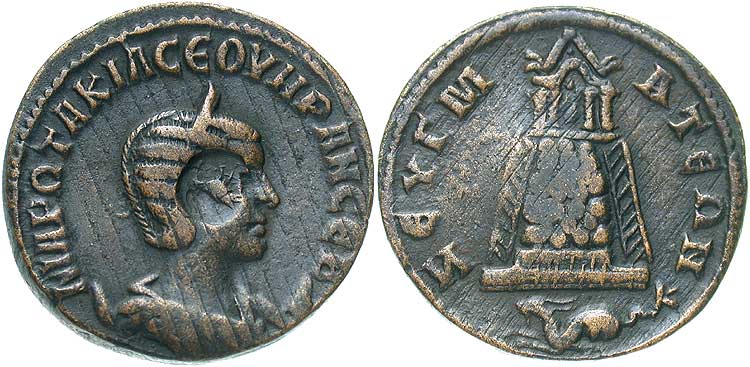 Coin issued by Philip the Arab for his wife Otacilia Severa; on the obverse,
a temple in Zeugma and the capricorn, a reference to Legio IV Scythica During the Roman Era, the Legio IV Scythica was camped in Zeugma. For about two centuries the city was home to high-ranking officials and officers of the Roman Empire, who transferred their cultural understanding and sophisticated lifestyle into the region. Thus the military formation acquired a Roman character and gave rise to an artistic trend of necropolis sculpture. In this respect, samples of beautiful art appeared in the form of steles, rock reliefs, statues, and altars. This unique trend in sculpture and art made the newly emerging Zeugma art well-recognized in whole region. Zeugma became considerably rich, owing to the liveliness created by Legion formation. At that time, there was a wooden bridge connecting Zeugma to the city of Apamea on the other side of Euphrates. Current excavations revealed that there was a large customs facility and a considerable amount of border trade in the city. The proof for this assumption came from the findings in the excavations carried out in Iskele üstü. In this site, 65,000 seal imprints (in clay, known as Bullae), were found in a place that is believed to have served as the archives for the customs of ancient Zeugma. The seal imprints used in sealing papyrus, parchment, moneybags, and customs bales are good indication of volume of the trade, the density of transportation, and the communication network once established in the region. Recent excavations and the legacy of ancient Zeugma In 1987 the Gaziantep Museum excavated two tomb chambers that had been broken into by antiquity smugglers in the necropolis southwest of Zeugma, revealing frescos on the walls and statues on the terraces in front of the chambers. These statues are now in the Gaziantep Museum of Archaeology. In 1992 the watchman at the site, Nusret Özdemir, reported renewed illegal activity here, and a trench dug by antiquity hunters was discovered in the centre of the city. Excavations commenced on the same spot by a team from Gaziantep Museum led by director Rifat Ergeç, uncovered a Roman villa and magnificent mosaic pavements. The first century AD villa consisted of galleries around an atrium with eight columns and rooms behind the galleries. The mosaic that adorned the villa's gallery depicted the marriage of Dionysus, god of wine and grapes, to Ariadne. Six of the ten figures portrayed in this mosaic were stolen on 15 June 1998. In further excavations here, part of the central panel of the mosaic pavement belonging to the terrace of another villa turned out to have been stolen long since, probably around 1965. The two figures are missing from the knees upward. The missing mosaic fragment later was found to be in the Menil Collection at Rice University in the city of Houston. The two figures seated side by side in this mosaic are the two legendary lovers, Metiochos and Parthenope. At the request of the Turkish Ministry of Culture, the stolen fragment was returned, and now the complete mosaic may be seen in Gaziantep Museum. The "Gypsy Girl" mosaic fragment (Zeugma Mosaic Museum)
When mosaic fragments were discovered during construction of the Birecik Dam wall that commenced in 1996, Gaziantep Museum had the work halted while excavations were carried out that revealed a Roman bath, gymnasium, and 36 mosaic panels which were added to the museum collection. In 1997, on the clay quarry area in front of the dam wall a large Bronze Age cemetery was discovered and excavated. Nearly eight thousand pottery vessels were found in 320 graves going back to the early Bronze Age. The museum staff worked unceasingly through the winter of 19981999, uncovering such important and beautiful finds as the Akratos and Gypsy Girl Mosaic and 65,000 bullae in an archive room at İskeleüstü, making Gaziantep Museum possessor of the largest collection of bullae in the world. In 1999, in a building within the lower quarter of the city, mosaics depicting the head of Dionysus and Oceanus and Tethys with sea creatures were discovered. From 1996 onward, with the threat of being submerged under the waters of the new dam, salvage excavations were carried out by C. Abadie Reynal of Nantes University in France, together with archaeologists from Gaziantep and Şanlıurfa museums. In 1999 a mosaic pavement depicting the mythological Minos bull was discovered at Mezarliküstü, and at the end of the excavation season, further mosaics were visible at the thresholds of other rooms. Not wishing to leave the mosaics at the mercy of the treasure hunters who are so active in the area, the acting director of Gaziantep Museum, Fatma Bulgan, decided to continue excavations through the winter months. Despite difficult weather conditions they went on to uncover a fountain with its own tank at a depth of three metres, a marble figure of Apollo, as well as, another mosaic pavement with nine figures depicting Achilles being taken by Odysseus to fight in the Trojan War. Also during salvage excavations under Mehmet Önal, an archaeologist from Gaziantep Museum, two more Roman villas were uncovered. These villas, which stood side by side, were burned and razed by the Sassanids in 252. The fact that they lay under three metres of rubble had protected them from treasure hunters. Their frescos, mosaics, and other artifacts were almost completely intact. A bronze statue of Mars, which aroused increased media interest in Zeugma, was found amongst storage jars in the larder of one of the villas. Altogether seventeen mosaic pavements have been revealed in the villas, whose walls were decorated with colourful frescoes. Excavations of Zeugma have been divided into three areas, initial priority being given to salvage and documentation in Zone A, which sank under the dam waters in early July. Work then moved on to Zone B, which was scheduled for submersion in October 2000 when the dam water reached its maximum level of 385 metres. Zone C, on the other hand, consists of the higher parts of the city that will not be affected by the new dam. A Zeugma excavation project conducted by Oxford Archaeology and supported by the Packhard Humanities Institute of Los Altos, California and the Ministry of Culture of Turkey, has recently unearthed three more ancient Greek mosaics in Zeugma. Oxford Archaeology also issued a 2013 report on the project. Zeugma is one of the foremost of Turkey's archaeological and historic sites, and the attention focused upon it from all over the world will undoubtedly continue over the years ahead. Related Links:
|
|
|
The Pasiphae Mosaic in Zeugma (Turkey)
 Image Credit: Frederic Lecut  Image Credit: Frederic Lecut This extraordinary mosaic covers
close to 800 Square feet of the floor of a huge meeting hall of a Roman
Villa from Zeugma (Turkey). It represents the myth of Queen Pasiphaé (sitting on her throne).
The Greek version of the myth goes like that (please keep in mind that the Greeks did not really like the Minoans, and were a very patriarchical culture) : Pasiphae - Sister of the beautiful and wicked Enchanteress Circe (who once had changed Odysseus comrades into hogs) - had been given as spouse to King of Crete Minos. For some obscure reason - either her or Minos had pissed him off - Poseidon cursed the Queen to fall in lust with a White Bull belonging to the King. The Queen hired the King's Engineer in Chief Daedalus to assist in her endeavour to be coupled to the Bull. With the help of his son and apprentice Icarus, Daedalos built a hollow wooden cow, wrapped in a bovine skin and endowed with mechanical life. Hiding inside this contraption the Queen was able to copulate with the Bull. From their unusual union she conceived and bore the hybrid bull-headed child Asterion, also called Minotauros by the Greeks. SOURCE: MosaicBlues by Frederic Lecut |
|
| FAIR USE NOTICE: This page contains copyrighted material the use of which has not been specifically authorized by the copyright owner. Pegasus Research Consortium distributes this material without profit to those who have expressed a prior interest in receiving the included information for research and educational purposes. We believe this constitutes a fair use of any such copyrighted material as provided for in 17 U.S.C § 107. If you wish to use copyrighted material from this site for purposes of your own that go beyond fair use, you must obtain permission from the copyright owner. | |
|
|
